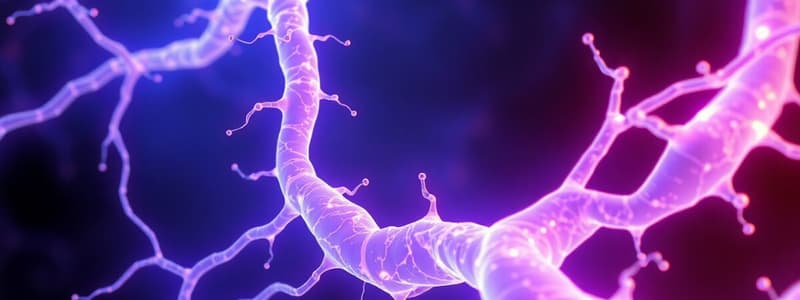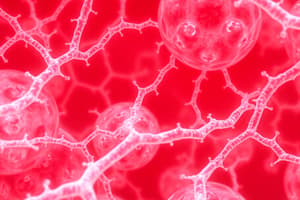Podcast
Questions and Answers
Which type of connective tissue fiber is primarily responsible for elasticity?
Which type of connective tissue fiber is primarily responsible for elasticity?
- Yellow elastic fibers (correct)
- White collagenous fibers
- Reticular fibers
- All of the above
Collagen fibers are flexible and elastic.
Collagen fibers are flexible and elastic.
False (B)
What is the primary protein that forms elastic fibers?
What is the primary protein that forms elastic fibers?
Elastin
Collagen type ___ is the most abundant in the human body.
Collagen type ___ is the most abundant in the human body.
Match the connective tissue fiber types with their characteristics:
Match the connective tissue fiber types with their characteristics:
What is the function of reticular fibers in connective tissue?
What is the function of reticular fibers in connective tissue?
Vitamin C is essential for the synthesis of collagen.
Vitamin C is essential for the synthesis of collagen.
Which cells are primarily responsible for collagen synthesis?
Which cells are primarily responsible for collagen synthesis?
The ground substance of connective tissue forms the extracellular ___.
The ground substance of connective tissue forms the extracellular ___.
Reticular fibers are primarily composed of which type of collagen?
Reticular fibers are primarily composed of which type of collagen?
What is the primary function of connective tissue?
What is the primary function of connective tissue?
Loose adipose connective tissue is characterized by an abundance of fiber.
Loose adipose connective tissue is characterized by an abundance of fiber.
What type of connective tissue is characterized by a gel-like matrix?
What type of connective tissue is characterized by a gel-like matrix?
The primary cells found in connective tissue are called ______.
The primary cells found in connective tissue are called ______.
Which type of fat tissue is responsible for energy and heat production?
Which type of fat tissue is responsible for energy and heat production?
Reticular connective tissue provides a supporting framework for organs.
Reticular connective tissue provides a supporting framework for organs.
Match the type of connective tissue with its description:
Match the type of connective tissue with its description:
What is the characteristic appearance of reticular connective tissue when stained?
What is the characteristic appearance of reticular connective tissue when stained?
The matrix of mucous connective tissue is known for being abundant and ______.
The matrix of mucous connective tissue is known for being abundant and ______.
Which type of connective tissue is primarily associated with the umbilical cord?
Which type of connective tissue is primarily associated with the umbilical cord?
Flashcards are hidden until you start studying
Study Notes
Connective Tissue Types & Characteristics
- Connective tissue (CT) fibers are composed of proteins forming long, thread-like structures.
- Three types of CT fibers:
- White collagenous fibers
- Reticular fibers
- Yellow elastic fibers
Collagen Fibers
- Collagen is the most abundant protein in the human body, making up 30% of its dry weight.
- Collagen synthesis: Fibroblasts, chondroblasts, osteoblasts, and odontoblasts produce collagen.
- Collagen starts as a precursor called tropo-collagen which matures into collagen.
- Tropo-collagen is primarily composed of glycine, proline, hydroxyproline, and hydroxylysine.
- Vitamin C is essential for normal collagen synthesis.
Collagen Fiber Characteristics
- Strong and resistant
- Flexible but not elastic
- White in their fresh state
- Different collagen fiber types exist (e.g., type I, II, III, etc.)
- Common locations: Ligaments and tendons
- Functions:
- Provide strength
- Resist stretching
Elastic Fibers
- Synthesis: Fibroblasts, smooth muscle cells, and chondroblasts produce elastic fibers.
- Structure: A core of elastin surrounded by fibrillin proteins.
- Characteristics:
- Stretch and recoil
- Flexible and elastic
- Yellow in their fresh state
- Function: Provide elasticity
- Common locations:
- Some ligaments
- Walls of large arteries (Aorta and its branches)
Reticular Fibers
- Structure: Composed of collagen type III
- Synthesis: Reticular cells
- Characteristics:
- Branch and anastomose (connect) to form a network
- Stained black with silver
- Function: Form a supportive network within organs (stroma)
- Common locations:
- Stroma of bone marrow
- Various organs
Ground Substance
- Definition: The extracellular substance surrounding CT cells and fibers.
- Components: Glycosaminoglycans (GAGs), proteoglycans, glycoproteins, and tissue fluid.
- Overall: Ground substance and fibers together form the extracellular matrix (ECM) of CT.
- Functions:
- Medium for transport
- Physical barrier against infection
Classification of CT
- General CT (CT proper): Soft, gel-like matrix.
- Specialized CT: Matrix varies in consistency.
- Cartilage: Rubbery
- Bone: Solid or hard
- Blood: Fluid
Connective Tissue Proper
- Loose connective tissue: More cells than fibers
- Areolar CT
- Adipose CT
- Reticular CT
- Mucoid CT
- Dense connective tissue: More fibers than cells
- Regular fibrous CT
- Irregular fibrous CT
- Yellow elastic CT
Loose Areolar CT
- Common location: Most abundant CT type, found beneath epithelia, surrounding capillaries, etc.
- Structure: Abundant, gel-like matrix. All fiber types present. All CT cells present (e.g., fibroblasts, macrophages, mast cells, white blood cells).
- Function: Supports epithelial cells
Loose Adipose CT
- Structure: Predominantly fat cells (adipocytes), with minimal other CT cells and fibers.
- Two types:
- White (yellow; unilocular) adipose tissue: Lobules of single-chamber fat cells separated by CT fibers.
- Brown (multilocular) adipose tissue: Lobules of multi-chamber fat cells separated by CT fibers, plus numerous blood capillaries and nerve fibers.
White Adipose Tissue
- Common locations:
- Subcutaneous tissue
- Around internal organs
- Function: Storage and mobilization of fat
Brown Adipose Tissue
- Color: Brown due to rich blood supply and mitochondria.
- Common locations: Limited distribution. Found in newborns (neck, axilla, around kidneys) but replaced by white fat in adults.
- Function: Energy and heat production
Reticular CT
- Structure: Reticular fibers and reticular cells forming a network.
- Staining: Black with silver.
- Common locations: Stroma of bone marrow and various organs.
- Function: Provides a supportive framework for bone marrow and organs.
Mucoid (Mucous) CT
- Structure: Abundant jelly-like matrix, with fibroblasts and fine collagen and reticular fibers.
- Common locations:
- Umbilical cord (Wharton's jelly)
- Pulp of teeth
Studying That Suits You
Use AI to generate personalized quizzes and flashcards to suit your learning preferences.




